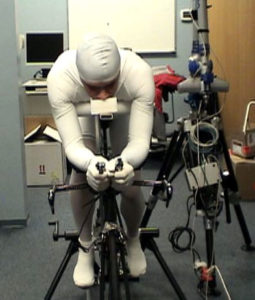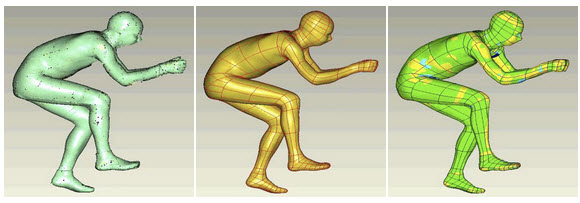 The Company:
The Company:
The company is a major manufacturer of high-tech bicycles with a worldwide distributorship and many professional endorsements. Their mission is to promote bike riding through innovative products and exceptional care for their dealers and customers.
The Challenge:
In their ongoing quest to improve the efficiency and aerodynamics of their bikes, company engineers have been testing them in a wind tunnel since 2000. The goal is to improve design to reduce drag, so the same amount of power will create more speed and better air flow. The wind tunnel testing works well for mechanical assemblies like the bikes and components. However, in order to obtain truly realistic results, the interaction between the bike and the rider must also be factored into any wind resistance testing plan.
Unfortunately, the wind tunnel environment proved to be harsh and tiring for a human rider. It was very difficult for a real rider to maintain an unvarying position for an entire day of testing, and therefore required expensive multiple runs and extended data sampling to ensure that the results were consistent. The company decided to create a life-sized, lifelike articulated foam figure to be used in their wind tunnel testing program. To create a meaningful simulation and obtain accurate specs, the figure needed to be symmetrical and in exactly the same position for each test event.
Off-the-shelf mannequins were not capable of assuming the position of a racing bicyclist; their backs and hips did not flex enough, and their toes did not articulate from the feet to connect with the pedals correctly. Also, such a figure would hinge in and out of position randomly at the moveable joints, so consistency was not assured. They needed an identically shaped figure on every bike to remove the rider drag variability from the wind tunnel testing.
The bike manufacturer found Laser Design through an Internet search for 3D laser scanning. The Laser Designaccount manager carefully discussed the scanning options with the engineers until they came up with an efficient plan to conduct the laser scanning bike-and-rider project. Consistency, stability, and stillness of the rider’s position were critical to the success of collecting accurate scan data, and eventually building a foam model.
The Process:
Since the position of the rider was so important to obtaining a viable model, the physical set-up of the bike and person took some forethought and precision. The difficulty in scanning people is that they tend to move because of muscle spasms and/or fatigue, so the challenge was to make the rider as comfortable as possible to minimize movement for the approximately 15 minutes it would take to scan him thoroughly.
To maintain the static position of the rider, the bike was stabilized in a bike stand. Other moving parts, such as the pedals, were braced or strapped down. Another unique set-up item was the rider’s clothing: he wore a white full bodysuit to help the scanner pick up details of the body’s basic geometry.
Laser Design engineers employed the Laser Design scanning system using the Platimum 8′ FaroArm® and the SLP-2000 laser probe, industry’s longest line laser probe (accurate to 127 µm) to precisely scan the free-form profile of the bicycle and rider. The 8″ laser line of the SLP-2000 probe meant that more data could be collected at a time, reducing the time it took to collect all the data. Also, the Laser Design scanning system using the portable and flexible FaroArm made it possible to capture data from all the nooks and crannies found on the bicycle and rider. Real-time on-screen monitoring assured a complete profile scan.

Because the laser scanning system projects a line of laser light onto all of the objects’ surfaces while cameras continuously triangulate the changing distance and profile of the laser line as it sweeps along, the problems of missing data on an irregular surface are greatly reduced. The laser line is moved back and forth over the scan objects’ surfaces until the complete area is captured. The system measures details and complex free-form geometry so that the object can be exactly replicated digitally. Laser scanners measure articles quickly, picking up to 75,000 coordinate points per second, and generate huge numbers of data points.
The Surveyor system’s native software, Surveyor Scan Control (SSC), took only 10 minutes to set up for this scan. The desired scan data density was predetermined by the operator. The pre-processed raw data of the bike and rider comprised over 2 million points. Usually millions of coordinates are kept to adequately define the part being scanned for either reverse engineering or inspection.
Scan time for the bike and rider was approximately 15 minutes. The versatile FaroArm system ensured the complete collection of all the bike and rider geometry. The scanning engineer made a complete scan of both sides in just a few minutes, and then was able to return to more irregular and hard-to-reach areas and collect more data with the higher level of detail.
Without non-contact laser scanning, this type of exact true-to-life shape replication would be virtually impossible. Computer animation could be used to put a rider in a specific position, but it would be impossible to ascertain whether the animated rider was exactly as desired. To use other scanning methods, such as touch technologies, would have taken an inordinate amount of time, results would have been incomplete, sparser, and inaccurate because the rider would not be able to maintain a static position for the long duration of the measurement process. The likelihood of having to revisit some part of the measuring process and collect more data is very high since these types of methods are not done in real time and provide no instantaneous feedback like high-speed 3D laser scanning does.
The Results:
After the 3D laser system scanned the entire bike and rider, the native SSC software automatically connected the point cloud data from multiple views into a common coordinate system in a single scan file. The data was then converted to STL and surfaces were created to make a full-scale CAD model. The bike company used SolidWorks for their design and analysis work so the model was saved as a “dumb” SolidWorks model for easy viewing and editing.
Even though Laser Design scanned and modeled both sides of the bike and rider, the human body is inherently asymmetric from side to side. Because the company engineers wanted a symmetrical model for testing, they used the laser scan data from one side of the SolidWorks model and then mirrored it to create a whole form, ensuring right-left symmetry. This was especially important to obtain consistent results for testing yaw, when the bike was at an angle to the wind. They performed the manipulation and clean up on the data and exported it into an IGES format, which can be used directly by CNC machines.
The foam model was made of high-density polyurethane foam with a metal skeleton inside for articulation of the joints. The model can be positioned consistently each time for reliable test results, and is durable to stand up to the wear-and-tear of repeated shipping and repositioning. The CNC-made figure will be used for all future wind tunnel tests. The results will be much more meaningful and consistent because the rider will always be in the same known position. When the final CNC figure is set up in the wind tunnel, biking clothes, shoes, and a helmet can be added for more realism and accurate test results
The company engineers found that 3D laser scanning was ideal for reverse engineering the complex shapes of the bike and rider, and in fact, was the only way they could accomplish such a remarkable project with pinpoint accuracy. “The laser scanning process at Laser Design was really slick,” commented the lead engineer. “We were very pleasantly surprised at the short time needed to scan the rider, the cleanliness of the scan data, and the ease of converting to the needed CAD format. With a short 2-3 day turnaround, even during a holiday week, the process fit our time frame and kept us on track.” The scan data was complete after the first iteration and no rework was needed, saving the company valuable time and money, and giving them a competitive advantage in their development and testing program with the innovative, realistic bike-riding model.
